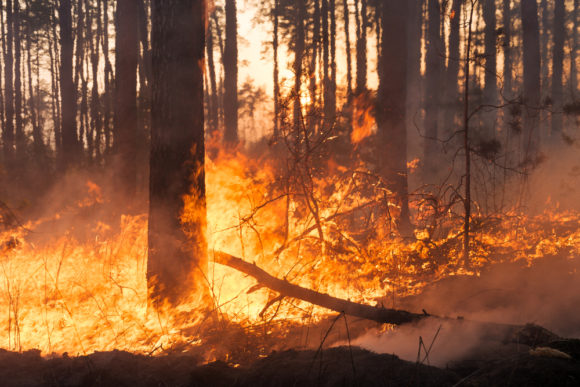Wildfires in Montana threatened rural towns and ranchland while victims of a California blaze returned to their incinerated community, even as the U.S. West faced another round of dangerous weather and smoke pollution fouled the air.
Firefighters and residents have scrambled to save hundreds of homes as flames advance across the Northern Cheyenne Indian Reservation in southeastern Montana.
An evacuation order was lifted Friday morning for about 600 people in and around the town of Ashland, just east of the reservation, signaling progress on the blaze that had burned out of control since Sunday.
But the fire was still burning near the tribal headquarters town of Lame Deer, where a mandatory evacuation remained in place and a second fire was threatening from the opposite direction.
Smoke from the blazes grew so thick Friday morning that the health clinic in Lame Deer was shut down after its air filters could not keep up with the pollution, said Northern Cheyenne Tribe spokesperson Angel Becker.
The evacuation order for the town will remain in place until the fire is under better control and the smoke clears, to protect the elderly and people with asthma and other conditions, Becker said.
“Lame Deer is sitting in between a couple ravines so when you get socked in it just sits here, and that’s not good for elders,” she said. “We’re trying to keep everybody out so we don’t have the potential for more sickness or anything else that’s going to bring down immune systems.”
More than 100 large fires were burning across the U.S. West with dozens more burning in western Canada. Th e smoke drove air pollution levels to unhealthy or very unhealthy levels in portions of Montana, Idaho, Oregon Washington and Northern California, according to Environmental Protection Agency air quality monitoring.
An air quality alert covering seven Montana counties warned of extremely high levels of small pollution particles found in smoke, which can cause lung issues and other health problems if inhaled.
The fires near Lame Deer combined have burned 275 square miles this week, so far sparing homes but causing extensive damage to pasture lands that ranchers depend on to feed their cows and horses.
Gusts and low humidity were creating extremely dangerous conditions as flames devoured brush, short grass and timber, fire officials said.
The same conditions turned California’s Dixie Fire into a furious blaze that last week burned down much of the small town of Greenville in the northern Sierra Nevada. The fire that began a month ago has destroyed some 550 homes.
The fire had ravaged more than 800 square miles — an area larger than the city of London — and continued to threaten more than a dozen rural and forest communities.
Containment lines for the fire held overnight, but it was just 31% surrounded and fire officials warned temperatures in Northern California would again reach triple digits Friday, bringing potentially critical fire weather in the afternoon.
Isolated thunderstorms in the Sierra Nevada could bring some moisture, but also gusty and erratic winds that could help spread the fire, Cal Fire officials said. Lightning could spark new blazes even as crews try to surround a number of other forest fires that were ignited by lightning last month.
Hot, dry weather with strong afternoon winds also propelled several fires in Washington state and similar weather was expected into the weekend, fire officials said.
In southeastern Oregon, two new wildfires started by lightning Thursday near the California border were spreading through chaparral, sagebrush and evergreen trees.
Authorities ordered the evacuation of an RV park that stood in the path of the Patton Meadow Fire, which rapidly expanded to 3 square miles in extremely hot and dry conditions Thursday evening west of Lakeview, Oregon. The vegetation is explosively dry due to extreme drought in the area of ranches, rural subdivisions and RV parks.
“To have a fire go from a single lightning strike to 2,000 acres in six hours, that’s substantial fire activity. We’re still in initial attack, this is a really fresh fire,” said U.S. Forest Service spokesperson Tamara Schmidt.
The fires are near the area torched by the monstrous Bootleg Fire, the nation’s largest blaze so far this year, which started July 6 and burned an area more than half the size of Rhode Island before crews gained the upper hand. The fire is not yet fully contained.
Triple-digit temperatures and bone-dry conditions in the state, which is undergoing a third day of extreme heat, could increase the fire risk in Oregon through the weekend.
In Montana, days of swirling winds spread flames in all directions, torching trees and blowing embers that flew across a dry landscape.
With 40-foot flames visible from parts of Lame Deer overnight Wednesday, firefighters worked urgently to keep the blaze from destroying houses.
After a brief break in the weather that brought cooler temperatures Thursday, it’s expected to start heating up again, reaching the 90s by Saturday and staying hot through Monday. Officials say that will dry out grasses and other fuels and make them more susceptible to burning.
Climate change has made the U.S. West warmer and drier in the past 30 years and will continue to make the weather more extreme and wildfires more destructive, according to scientists.
More than 6,000 square miles have been burned in the U.S. so far this year. That’s well ahead of the amount burned by this point last year, but below the 10-year average, according to the National Interagency Fire Center.
Eugene Garcia in Greenville, California, Olga R. Rodriguez in San Francisco and Gillian Flaccus in Portland contributed to this report.
Related:
- Northern California’s Dixie Fire Has Affected 800-Plus Structures, And High Winds Are on Their Way
- Grim California Wildfire Outlook Has Insurers Forking Over Big Bucks for Modeling
- Californians Warned to Prepare for Brutal Heatwave, Fire Risk
Was this article valuable?
Here are more articles you may enjoy.



 Winning Lawsuit Against Titan Sub Owner Could Be Difficult, Experts Say
Winning Lawsuit Against Titan Sub Owner Could Be Difficult, Experts Say  California Commissioner Moves to Implement Insurance Rate Review Reforms
California Commissioner Moves to Implement Insurance Rate Review Reforms  California Commissioner Orders Insurance Cancelation Moratorium for 185K Residents
California Commissioner Orders Insurance Cancelation Moratorium for 185K Residents  Construction Defects Are Not Covered Property Damage in Commercial Liability Policy
Construction Defects Are Not Covered Property Damage in Commercial Liability Policy 

